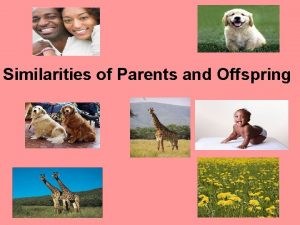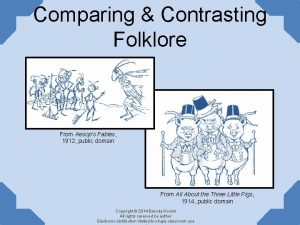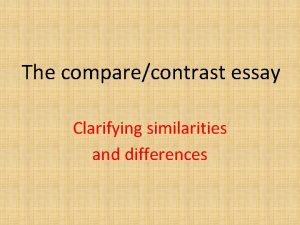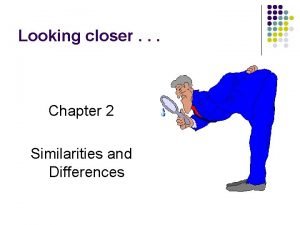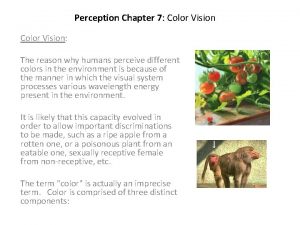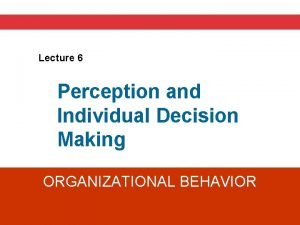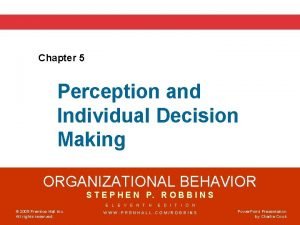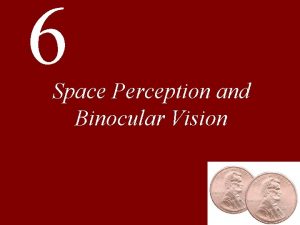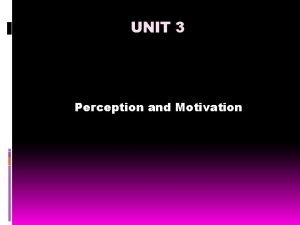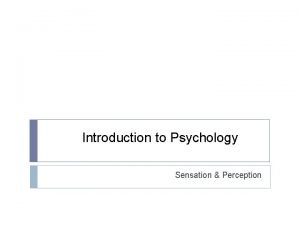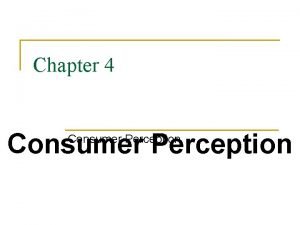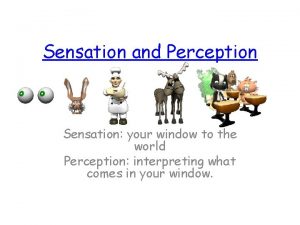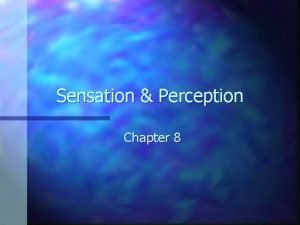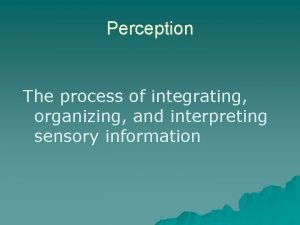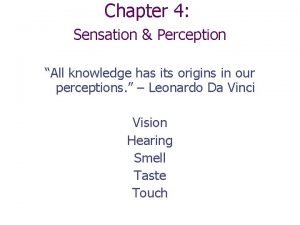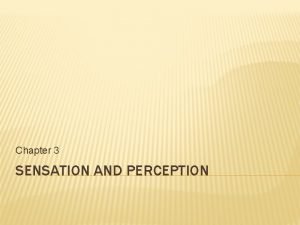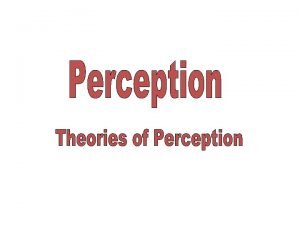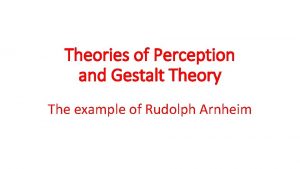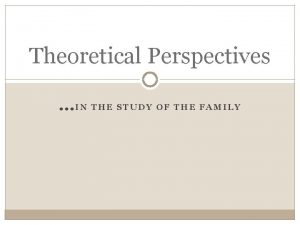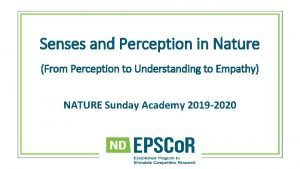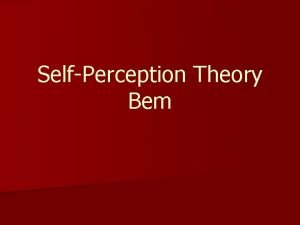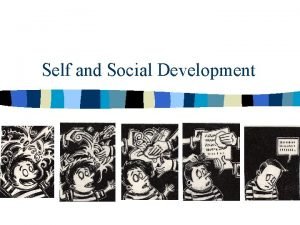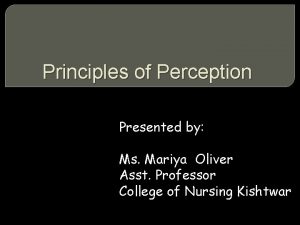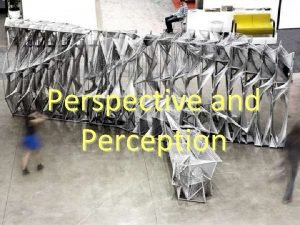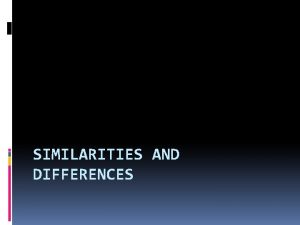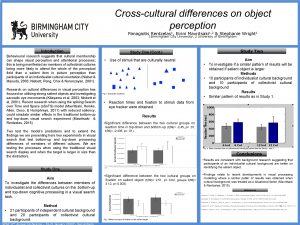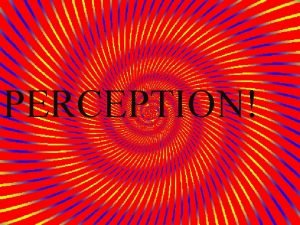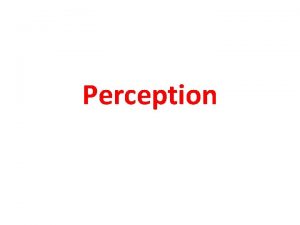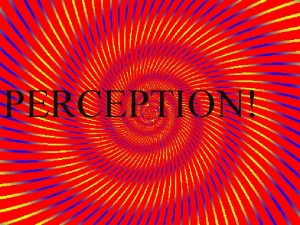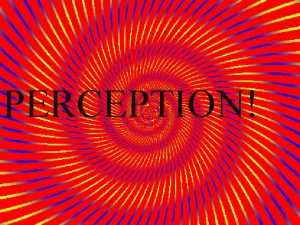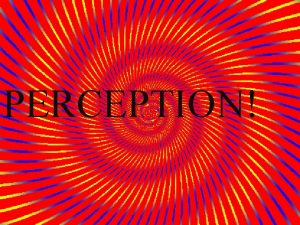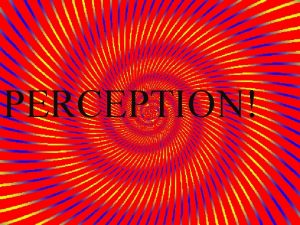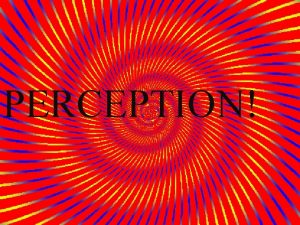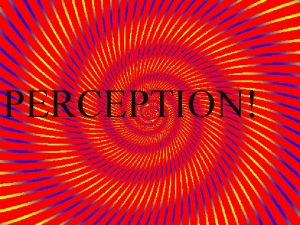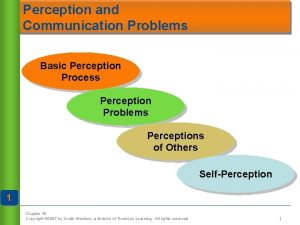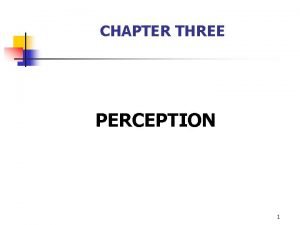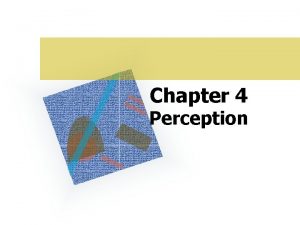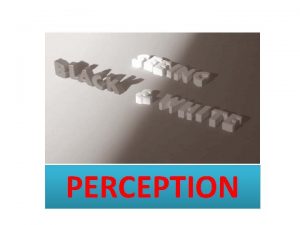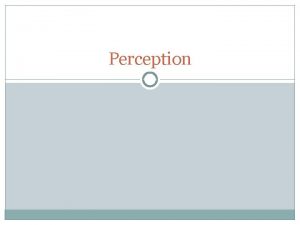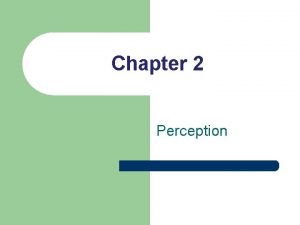LECTURE 3 Crosscultural similarities and differences in perception



































































- Slides: 67

LECTURE 3 Cross-cultural similarities and differences in perception Jiří Čeněk

SENSATION AND PERCEPTION IN CROSSCULTURAL CONTEXT Content: 1. 2. 3. 4. 5. 6. 7. Basic terms and principles of perception and cognition. Perception of patterns and pictures Perception of depth Drawing pictures Perception of color Perception of time Face recognition

SENSATION AND PERCEPTION

PERCEPTION Sensation: Physical stimuli → Sensory organs → Transduction → Neural impulse → Cortex → Impulses transformed into sensations Perception and cognition: Interpretation of sensations � Sensations: Represent first experience with outside stimuli, consist of meaningless bits of sensory information

Elements of culture Forming culture

Role of Experience

ROLE OF EXPERIENCE

ROLE OF EXPERIENCE Perceptual sets: Blakemore, Cooper (1970) https: //www. youtube. com/watch? v=Qzk. Mo 45 pc. Uo

EXPERIENCE Perceptual set = expectations � Dependent on our previous experience with the enviroment. � Some interpretations (memories of previous perceptions + feelings + meanings + behavior) of the reality are more likely to occur. � Some perceptual sets common to people from 1 culture are not necessarily developed in people from other culture. → People from different culture percieve differently.

ROLE OF EXPERIENCE Differences in the environment = Different past experience = Different perceptual sets = Different perception of the world

Role of Values and Needs

HOW CULTURE INFLUENCES OUR PERCEPTION? –VALUES AND NEEDS Example: Bruner & Goodman (1947). Value and needs as organizing factors in perception. �N = 30, 10 year old, normal intelligence � 3 groups 2 experimental: poor and rich families – coins (1 x according to memory, 1 x after presentation) 1 control: cardboard discs of the same size

HOW CULTURE INFLUENCES OUR PERCEPTION? Results: � Coins pictured larger than discs (higher value).

HOW CULTURE INFLUENCES OUR PERCEPTION? Results: � Poor overestimate size of the coin considerably more than the rich.

HOW CULTURE INFLUENCES OUR PERCEPTION? Results: � The higher is the value of the coin, the greater is the deviation from apparent and actual size.

HOW CULTURE INFLUENCES OUR PERCEPTION? –VALUES AND NEEDS Bruner & Goodman conclusion: � Need for money among the children from poor families (Boston slums) influenced their perception of the coins. � Replicated in Hong Kong with similar results.

PREHISTORY OF VISUAL PERCEPTION RESEARCH

PREHISTORY OF VISUAL PERCEPTION RESEARCH Civilized vs. „primitive“ cultures

PREHISTORY OF VISUAL PERCEPTION RESEARCH Deregowski et al. (1972). Perceptual recognition in a remote Ethiopian population. Research conducted among Me`en (Bodi) people in south Ethiopia. Limited access to formal education, Little exposure to pictures.

PREHISTORY OF VISUAL PERCEPTION RESEARCH Difficulties with recognition Usage of other senses

PREHISTORY OF VISUAL PERCEPTION RESEARCH 1. 2. Segall et al (1990): hypotheses about differences among people from civilized and developing countries Carpentered world hypothesis Sophistication hypothesis

PREHISTORY OF VISUAL PERCEPTION RESEARCH Carpentered world hypothesis: The tendency of people from highly carpentered environments to perceive non-recangular retinal images as rectangular objects. Sander parallelogram

PREHISTORIE VÝZKUMŮ ZRAKOVÉ PERCEPCE Sophistication hypothesis: 3 D-2 D-3 D transformation Depth cues � Convergence, binocular disparity, linear perspective, relative size, etc. Experience with pictorial material determines our ability to interpret the depth cues 2 D a 3 D perceivers

PREHISTORY OF VISUAL PERCEPTION RESEARCH Hudson (1960). Pictorial depth perception in subcultural groups in Africa. � Study of depth cues (relative size, linear perspective, interposition) � Illiterate people in South Africa

PREHISTORY OF VISUAL PERCEPTION RESEARCH Deregowski (1980). Illusions, patterns and pictures a Cross-cultural perspective.

PREHISTORY OF VISUAL PERCEPTION RESEARCH

PREHISTORY OF VISUAL PERCEPTION RESEARCH Where will the pointer be if it is on the nearest picture? 2 D viewers cannot do this.

2 D PERCEIVERS Very few 2 D perceivers nowadays: � Globalization � Internet, etc. Exception: uncontacted peoples https: //en. wikipedia. org/wiki/Uncontacted_peoples

UNCONTACTED PEOPLES Example: North Sentinel Island (India)

PERCEPTION OF PICTORIAL MATERIAL Conclusion: � Picture perception involves a set of skills � = deal with variety of cues + use these cues appropriately to a given situation � = one has to learn to read the pictures as representations of the real space � Cultures differ in: The cues which are used The relative importance attached to the cues = One culture may not be able to interpret drawings from another culture.

MODERN THEORIES – FOCUS SHIFTS FROM THE ENVIRONMENT TO CULTURE (SOCIAL RELATIONS)

HOLISTIC AND ANALYTIC COGNITIVE STYLE N ( ISBETT) Comparison of 2 industrial cultural regions: � The West (Western Europe, USA) � The East (China, Japan, South Korea)

DIFFERENCES BASED ON THE CULTURE Nisbett: Attention to object vs. field � Differences in attention and perception among cultures � Masuda (2001)

DIFFERENCES BASED ON THE CULTURE Results: Differences in cognitive orientation Asians attend more holistically � Attend more to the background (context) � Mutual relationships of objects � Problems with separating an object from a background Westerners attend more analytically � Attend more to the focal objects � Attend more to their attributes Asians: 70 % more about the background, 2 x more about relationships, worse recall with novel/neutral background

DIFFERENCES BASED ON THE CULTURE Change blindness https: //www. youtube. com/watch? v=0 gr. ANlx 7 y 2 E https: //www. youtube. com/watch? v=v. BPG_OBg. TWg

ESTETICS Photographs: role of figure and background

DIFFERENCES BASED ON THE CULTURE Possible explanations: Social relations Identity Philosophy Religion Etc.

DIFFERENCES BASED ON THE CULTURE Differences in social relationships: Independency vs. Interdependency Asians: Self-reference: � Social identity: „I am a university of Beijing student. “ � Relationships: „I am a son. “ Value social harmony Communication between child and mother Americans: Self-reference: � Abstract personality traits: „I am clever. “

SPECIAL TOPICS

DRAWING PICTURES

DRAWING PICTURES Drawing = converting 3 D perceptions into 2 D paintings. People without formal schooling, young children and artist thousands years ago lack this ability. → Perceptual distortions of pictures � Less affected by visual cues � Polydimensional perspective

LINEAR PERSPECTIVE

POLYDIMENSIONAL PERSPECTIVE Aboriginal art

POLYDIMENSIONAL PERSPECTIVE Egytian and Cretan art � Head and legs in profile � Torso and eye frontal

POLYDIMENSIONAL PERSPECTIVE

POLYDIMENSIONAL PERSPECTIVE African art

PERCEPTION OF COLOR Objects dont have color

PERCEPTION OF COLOR 3 dimensions of color: � Hue (= color) � Brightness (= colors intensity) � Saturation (= colors purity) Does a color perception have a cultural variation?

PERCEPTION OF COLOR Sapir-Whorf hypothesis

PERCEPTION OF COLOR Language-related theories of color perception: � Emphasis on role of laguage in perception of color � Different identification and labeling of colors � Words linked to various lenghts of visible spectrum Perception-language paradox: � Healthy individuals able to percieve the same range of colors X some languages lack words for certain colors.

CATEGORIZATION OF COLORS Berlin & Kay (1969): color classifications among cultures We can predict what colors a culture knows based on the number of color terms. If a culture has X colors, what colors would it be? � 2 ? : � 3 ? : black + white / dark (cool) + light (warm) � 5 ? : red � 6 ? : yellow + green � 7 ? : blue � 11: brown purple, pink, orange, gray

SEMANTIC MEANING OF COLORS Example: Adams & Osgood (1973). A cross-cultural study of the affective meaning of color. Semantic differential

SEMANTIC MEANING OF COLORS Example: Adams & Osgood (1973). A cross-cultural study of the affective meaning of color. Semantic differential 3 dimensions of affective meaning

SEMANTIC MEANING OF COLORS Example: Adams & Osgood (1973). A cross-cultural study of the affective meaning of color. � 23 countries, semantic analysis: feelings about colors � Red: active � Black, grey: bad � White, green, blue: good � Yellow, white, gray: passive People add to their perception of colors a subjective meaning.

SYMBOLIC MEANING OF COLORS Red � Violence, � Japan: revolt, revolution philantropy, vitality � China: luck

SYMBOLIC MEANING OF COLORS Black and white � White: good, pure, familiar in all countries � Black: unclean, negative, unknown � More positive evaluation of light-skinned figures than of darkskinned ones in both Europe and Africa (preschool children) Why do You think is that so?

OTHER TRENDS IN COLOR INTERPRETATION Discussion: Skin and hair whitening.

PERCEPTION OF TIME

PERCEPTION OF TIME Have You ever traveled to African, Arab, Asian countries? Have You ever been to Germany, Denmark, Finland or Holland? Have You noticed any differences in punctuality compared to Czech Republic?

PERCEPTION OF TIME People from different cultures treat time differently: some are puncual, some are not. Differences caused by different perception of time. � Western world: precise measures of time (clock time) � 1 h, 1 m, 1 s Arab cultures: 3 sets of time No time at all, now (of varying duration), forever (too long) Time measured by duration of events (event time) � Africa: individual vs. tribal time � In Swahili Sasa: Now, sense of immediacy Zamani: Past, connector of individual souls Special case: Piraha tribe http: //www. scribd. com/doc/24699041/Perception-of-Time-in. Different-Cultures

CONSEQUENCES OF DIFFERENT TIME PERCEPTION Western world � Time as a commodity (can be bought and sold) Arab cultures � More attention to „now“ than to events in the future � Time and money separated � Cant arrange a meeting at a certain time. African cultures � Cant arrange a meeting at a certain time.

FACE RECOGNITION

FACE RECOGNITION Experiments: � Series of photographs of own-group members and of other ethnic group. � Part of the photos presented again together with distractors. � The respondents have to indicate for each photograph whether or not they saw the picture before. 1 st set 2 nd set

FACE RECOGNITION Own-race bias � Definition: „People have more difficultly differentiating and remembering faces of another race compared to faces within ones own race. “ � Caused by differential experience with own- and other-race faces.

FACE RECOGNITION Factors influencing face recognition: � Presentation time � Delay time between presentation and recognition � Awareness taking part in recognition experiment � Same or different photographs Results (meta-analysis) � 1, 4 x more likely to identify correctly a previously seen face of ingroup � 1, 6 x more likely to identify incorrectly a previously seen face of outgroup

FACE RECOGNITION Contact hypothesis � Correct recognition is a function of frequency of contact. � Quality of contact also important. European Americans have relatively better recognition of of African American faces than no fans (Sporer 2001).

READING Berry: Chapter 8: Perception (197 -216) Kitayama: pages 577 -580 (Holistic and analytic reasoning – Attention to object vs. Attention to field) Shiraev: pages 111 -114 (Perception of color) + 116117 (Perception of time)
 If katie has brown eyes a dominant trait we know
If katie has brown eyes a dominant trait we know With ppst domain 5 in mind
With ppst domain 5 in mind Similarities and differences of ants and grasshopper
Similarities and differences of ants and grasshopper Compare sparta and athens
Compare sparta and athens Who wrote raymond's run
Who wrote raymond's run Women and development wad
Women and development wad Perception differences
Perception differences Essay about similarities and differences
Essay about similarities and differences Cross cultural differences and similarities
Cross cultural differences and similarities Identifying similarities and differences
Identifying similarities and differences Marzano similarities and differences
Marzano similarities and differences What is the similarities and differences of fascism
What is the similarities and differences of fascism Identifying similarities and differences examples
Identifying similarities and differences examples Similarities and contrast
Similarities and contrast Research4life password
Research4life password Comparison and contrast example paragraph
Comparison and contrast example paragraph New criticism and formalism differences
New criticism and formalism differences Similarities and differences table
Similarities and differences table Identifying similarities and differences
Identifying similarities and differences Similarities and differences
Similarities and differences 01:640:244 lecture notes - lecture 15: plat, idah, farad
01:640:244 lecture notes - lecture 15: plat, idah, farad Chapter 5 sensation and perception
Chapter 5 sensation and perception Chapter 7 vision and perception
Chapter 7 vision and perception Test papi kostick
Test papi kostick Perception and individual decision making
Perception and individual decision making Gestalt principles of sensation and perception
Gestalt principles of sensation and perception A subjective perception of vitality and feeling well
A subjective perception of vitality and feeling well Perception and decision making in organizational behavior
Perception and decision making in organizational behavior Subjective perception of vitality and feeling well
Subjective perception of vitality and feeling well Perceptual set ap psych
Perceptual set ap psych Binocular disparity
Binocular disparity Perception and motivation
Perception and motivation Example of perception
Example of perception Sensation & perception crossword review
Sensation & perception crossword review Chapter 3 sensation and perception
Chapter 3 sensation and perception Sensation and perception
Sensation and perception Chapter 6 sensation and perception
Chapter 6 sensation and perception Psychology chapter 4 sensation and perception
Psychology chapter 4 sensation and perception Sensation and perception in marketing
Sensation and perception in marketing Sensation and perception
Sensation and perception Sensation and perception
Sensation and perception Kinesthesis and vestibular sense
Kinesthesis and vestibular sense Max martin kostick
Max martin kostick Max kostick
Max kostick Sensation perception
Sensation perception Chemical substance that alters perceptions and moods
Chemical substance that alters perceptions and moods Sensation and perception uu
Sensation and perception uu Chapter 7 managing risk vision and perception
Chapter 7 managing risk vision and perception Chapter 4 sensation and perception
Chapter 4 sensation and perception Chapter 3 sensation and perception
Chapter 3 sensation and perception Habib yammine-wazn il mu'allaqat imru'al qays
Habib yammine-wazn il mu'allaqat imru'al qays Differences between joyce and woolf
Differences between joyce and woolf Meiosis and mitosis venn diagram
Meiosis and mitosis venn diagram What are the differences of dna and rna
What are the differences of dna and rna Gregorys constructivist theory
Gregorys constructivist theory Gestalt theory of perception examples
Gestalt theory of perception examples Perspective vs perception
Perspective vs perception Perception in psychomotor domain
Perception in psychomotor domain Subjective perception
Subjective perception Nature of perception
Nature of perception Self perception theory bem
Self perception theory bem Self image vs self perception
Self image vs self perception A clear perception of your personality
A clear perception of your personality Different self concept
Different self concept Self image vs self perception
Self image vs self perception Principle of adaptability in perception
Principle of adaptability in perception Perspective quotes
Perspective quotes Perception checks
Perception checks
